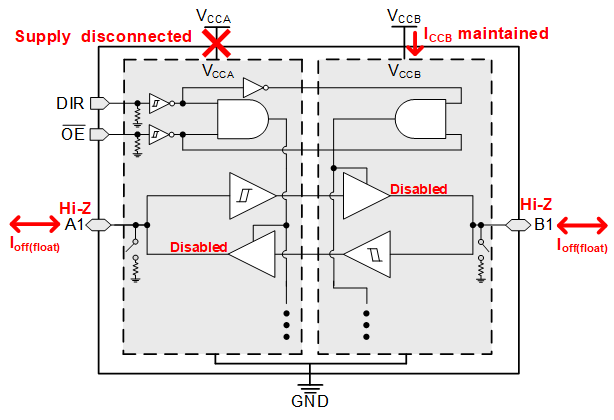-
Robust Voltage Level Translation with the LXC Family
Robust Voltage Level Translation with the LXC Family
Trademarks
All trademarks are the property of their respective owners.
1 Introduction
The LXC family is an addition to TI's Direction-controlled Level Translation portfolio. This family has a wide supply range of 1.1 V to 5.5 V making ideal for any system using common digital I/O voltages. The LXC family name comes from it being the next generation to the current popular LVC family of voltage translation devices. This allows for easy interchangeability while still maintaining the current circuit design and popular parameters like the high drive strength. However, the LXC family benefits from new design process advancments allowing it to have other improved parameters like lower power consumption making it better suited for battery powered applications. To take it a step further, the LXC family is packed with features making it robust for harsher noise environments that can be seen in both automotive and industrial systems.
2 Input/Output Architecture
This section covers the improved I/O architecture and characteristics of the LXC family. This new architecture is a piece of what makes the LXC family robust. In certain circumstances, it can also lead to a reduction in passive components. Figure 2-1 illustrates a simplified block diagram of the I/O structure along with the control circuity inputs.
2.1 Integrated Pull-Down Resistors
As shown in Figure 2-1, the LXC family of translators have integrated pull-down resistors to help avoid floating inputs. The A-port and B-port I/O have been equipped with dynamic pull-downs that are activated when the device is disabled. The control inputs, DIR and OE, will have 5 MΩ static pull-downs always present. If the control inputs are not actively driven by an external source, the default state of the device is enabled with direction set for B to A data flow. Refer to the Feature Description section of the data sheet for more info on these pull-downs.
2.2 Input Characteristics
2.2.1 Schmitt-Trigger Inputs
The LXC family of translators have schmitt-triggers integrated in all input buffers. Schmitt-triggers are key components in making the LXC family robust. They provide more noise immunity to accommodate all types application environments, and they eliminate any negative side effects of digital signals with slow edge rates as decribed in Solving CMOS Transition Rate Issues Using Schmitt-Triggers. Figure 2-2 and Figure 2-3 illustrate the dynamic power benefits provided by the Schmitt-trigger inputs.
 Figure 2-2 Supply Current
Across Input Voltage (1.2 V, 1.5 V, and 1.8 V Supply)
Figure 2-2 Supply Current
Across Input Voltage (1.2 V, 1.5 V, and 1.8 V Supply) Figure 2-3 Supply Current
Across Input Voltage (2.5 V, 3.3 V, and 5 V Supply)
Figure 2-3 Supply Current
Across Input Voltage (2.5 V, 3.3 V, and 5 V Supply)2.3 Output Characteristics
The LXC family of translators have strong balanced output drive. This extra drive strength will make these level shifters ideal for systems with long trace lengths or applications like LED driving that require up to 20 mA. The plots below highlight the typical output characteristics of the LXC family.
 Figure 2-4 Typical
(TA=25°C) Output High Voltage (VOH) vs Source Current
(IOH)
Figure 2-4 Typical
(TA=25°C) Output High Voltage (VOH) vs Source Current
(IOH) Figure 2-6 Typical
(TA=25°C) Output High Voltage (VOL) vs Sink Current
(IOL)
Figure 2-6 Typical
(TA=25°C) Output High Voltage (VOL) vs Sink Current
(IOL)  Figure 2-5 Typical
(TA=25°C) Output High Voltage (VOH) vs Source Current
(IOH)
Figure 2-5 Typical
(TA=25°C) Output High Voltage (VOH) vs Source Current
(IOH) Figure 2-7 Typical
(TA=25°C) Output High Voltage (VOL) vs Sink Current
(IOL)
Figure 2-7 Typical
(TA=25°C) Output High Voltage (VOL) vs Sink Current
(IOL)3 LXC Features
3.1 VCC Isolation and VCC Disconnect
In conjunction with the dyncamic pull-downs, the LXC family has introduced the new VCC Disconnect feature. This feature is an improvement to the already existing VCC Isolation and Partial Power Down features. As illustrated in Figure 3-1, the VCC Disconnect feature will discharge any charge at the supply pin allowing the device to go into a disabled state whenever the supply node is floated rather than driven to ground.
 Figure 3-1 VCC Disconnect
Feature
Figure 3-1 VCC Disconnect
FeatureThis feature is beneficial for applications where the translation device is connected to a power source through a load switch. Refer to the Feature Description section of the data sheet for more info on the VCC Disconnect feature.